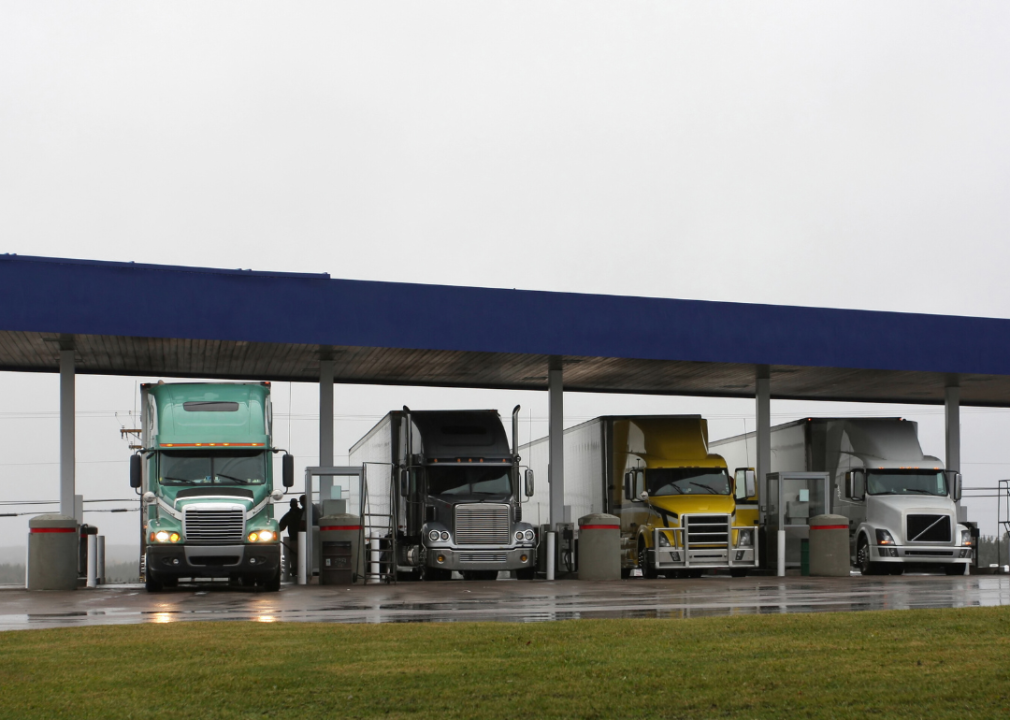As semitrucks face parking crisis, the scramble is on to find solutions

Canva
As semitrucks face parking crisis, the scramble is on to find solutions
Two men in checked shirts, jeans, and baseball hats shaking hands. There are three truck cabins in the background behind them.
While car parking is required in most local ordinances and integral to basic community or city design, commercial truck parking is often illegal in those same areas. With insufficient or nonexistent sanctioned commercial truck parking, illegal parking in dense areas like Queens, New York, is commonplace (and highly controversial).
For many commercial truckers, the only alternative to illegal parking is to keep driving—oftentimes further than the 11-hour limit set by the Federal Motor Carrier Safety Administration. To solve the crisis, more truck parking is needed. But whose responsibility is it to figure that out—and pay for it? Truck Parking Club dug into the semitruck parking crisis in the U.S. and explored who’s responsible for coming up with—and paying for—the solutions.
Every day, the average American uses products that were at some point transported by a semitruck. These trucks travel hundreds of miles, accounting for moving more than 73% of goods in the U.S. by value. Despite being vital to the nation’s economy, however, these inconveniently large vehicles are kept out of sight and out of mind. That means when it comes to parking (and resting), the drivers responsible for transporting essential goods are faced with significant challenges.
![]()

Canva
A parking double standard
Two red large trucks on the highway.
Some of the highest traffic areas for long-haul trucks are those that are the least accommodating for practical solutions. Rural states are typically better at meeting the demands of big-rig truck parking, but in more urban areas, the calculus flips, according to data from the Bureau of Transportation Statistics analyzed by Stacker. Massachusetts has about 35.5 parking spaces for every 100,000 truck miles traveled, while New York has about 57.1 spaces. Compare this with New Hampshire, where 230 parking spaces exist for every 100,000 truck miles.
In places like New York City, where more than 70% of goods are transported by trucks, semis can only rest at very few commercial parking lots which are typically bursting to capacity. In Clark County, Nevada, there have been reports of residents placing dirt piles on vacant lots to prevent trucks from parking—an example of residents opposing infrastructure adjustments in their immediate area despite the amenities trucks provide them on a daily basis.
In his book, “Paved Paradise: How Parking Explains the World,” Henry Grabar, a Slate journalist, argues that far too much space and resources are devoted to residential parking in the United States, a large contributing factor in the national semitruck parking shortage. “The core distinction between the truck parking and car parking is that car parking is required by law in most jurisdictions for most land uses,” Grabar told freight market reporting agency FreightWaves. “Truck parking has become something that nobody wants in their neighborhood ever.”
As it stands, there are over 11 truck drivers for every parking space, and a leading concern is safety. In a 2020 survey, the Federal Highway Administration found that 98% of drivers struggle to find safe parking for their trucks. In addition, they spend an average of 56 minutes a day to ensure a safe spot, according to a study from the American Trucking Associations. When they can’t find suitable parking, more than half admit to taking a risk and parking in unauthorized or undesignated spots at least three times a week. These risks can sometimes have fatal consequences: In July 2023, three passengers were killed and 14 injured when a Greyhound bus crashed into three tractor-trailers parked along an exit ramp along Interstate 70 near St. Louis.
While there aren’t yet concrete solutions for commercial parking, things have gotten more complicated for the truckers who are looking. Drivers are only allowed to drive a maximum of 11 hours within a 14-hour window before they’re required to take a 10-hour break, according to the FMCSA. These hours of service regulations have been around since 1937, but a 2017 mandate to use electronic logging devices has made it more difficult for drivers to work around these hours and yielded no significant safety benefits. According to a study of 2017 through 2018 data, it may have even caused the opposite effect, increasing the frequency of unsafe driving for truckers in a hurry.
For truck drivers, every minute of moving counts. Their wages rely on the miles logged each day, so limited time coupled with scarce parking has created a headache for America’s 2 million long-haul truckers.

Canva
Where responsibilities lie
Four large trucks parked outdoors under the blue roof.
It’s important to remember that parking isn’t just finding a space for the truck itself. Of the lucky truckers who are able to find a space at a stop, it’s where they will eat, shower, and sleep. Beyond being considered “a national safety concern,” this is a quality-of-life issue.
An obvious solution is to simply increase the amount of parking offered to truck drivers. What that looks like—and more specifically, who will pay for it—has yet to be determined. There are existing publicly owned rest areas and travel centers, but parking is getting harder and harder to find at these stops.
According to survey findings shared by the Department of Transportation, many commercial truck stops typically operate at more than 100% capacity overnight, on weekdays, and between May and October. Without more public land dedicated to providing safe overnight parking and resources for truck drivers, this issue is likely to get worse. The same survey also found that about 87% of all truck parking is at private truck stops, which may cost $10 to $50 per night—a relatively steep fee for an industry working with razor-thin margins.
Some entrepreneurs are building on this demand for parking by developing apps that allow truck drivers to book and secure their spots. If successful, this business model could become attractive, potentially resulting in more parking. Venture capitalists are skeptical, however. “We aren’t convinced these are technology businesses that can generate venture-scale returns,” Santosh Sankar, co-founder of venture capital firm Dyanmo Ventures, told FreightWaves. “It instead feels like a real estate investment that has some technology strapped on top of it for discovery and payment.”
While the economics have yet to be threshed out, solutions are being sought at all levels of the government.
After the passing of Jason’s Law—named after Jason Rivenburg, who was murdered while parked in an unsanctioned spot in South Carolina—lawmakers have tried to introduce a bill that aims to allot $755 million for truck parking. It has been introduced to the House, but an analysis by GovTrack only gives it a slim 35% chance of passing.
There have been wins, too. The American Trucking Association recently praised Republican Rep. Steve Womack for including $200 million in the House Transportation Appropriations Subcommittee funding bill dedicated to expanding truck parking. The Department of Transportation also has five federal projects that will add about 1,000 parking spaces for drivers along key corridors in Florida, California, and Wisconsin. These were funded by the Bipartisan Infrastructure Law that passed Congress in 2021 and allocated through the Infrastructure for Rebuilding America program.
States have similarly sought solutions within their jurisdiction. Washington state, for example, has directed its Department of Transportation and an investment board to study parking needs and identify opportunities to partner with cities, counties, ports, and private entities. This Truck Parking Implementation Plan is due to be submitted by Dec. 1, 2024.
Cities have also started to make some accommodations. In New York City, city council member Nantasha Williams introduced the Trucks Resting in Urban Communities Act, which allows overnight curbside parking in 21 industrial and manufacturing zones throughout locations like Brooklyn Navy Yard, Jamaica, and the Northshore of Staten Island. In an opinion piece for Queens Daily Eagle, Williams and Kendra Hems, president of the Trucking Association of New York, advocated for the legislation by writing, “It’s the kind of smart urban planning that can keep our city and residents moving forward.”
While pieces of legislation like these make their way through the system, residents can expect to see parked trucks in perhaps unsafe or inadvisable places—a less-than-desirable side effect of a consumer industry run on wheels.
Story editing by Carren Jao. Additional editing by Kelly Glass. Copy editing by Tim Bruns.
This story originally appeared on Truck Parking Club and was produced and
distributed in partnership with Stacker Studio.
